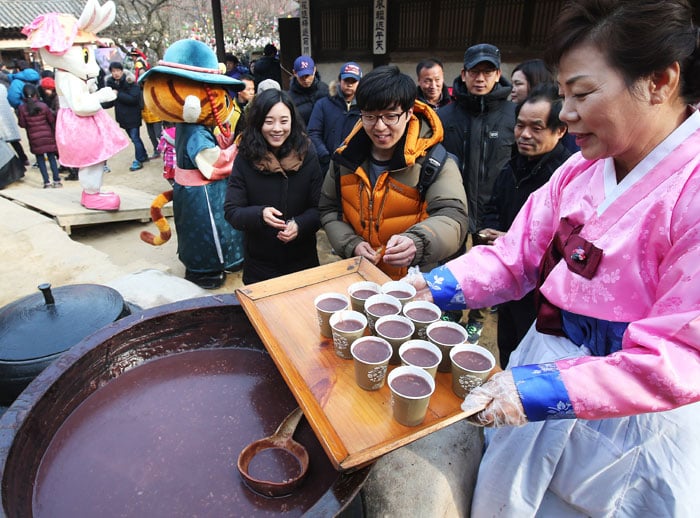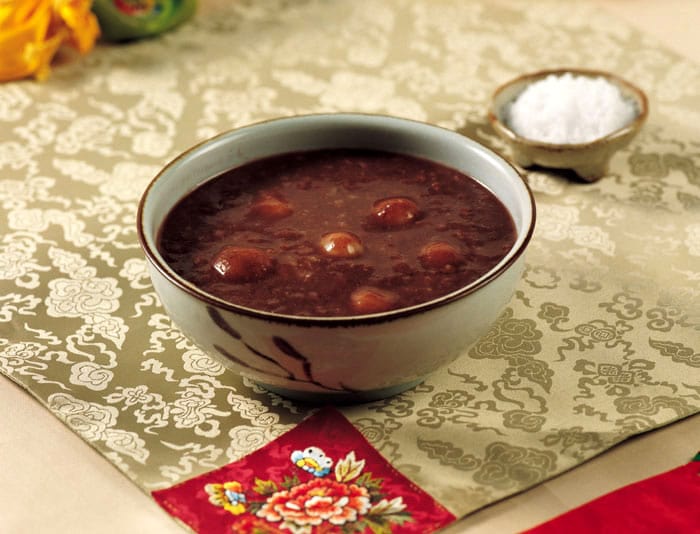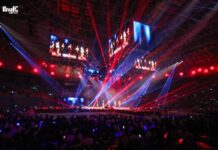
A staffer at the Korean Folk Village in Yongin-si City, Gyeoggi-do Province, offers patjuk, or rice and red bean porridge, to visitors to mark Dongji, the winter solstice, which falls on Dec. 22 this year.
Earlier this week, it was easy to see people enjoying red bean porridge, or patjuk, in many places across the country, ranging from the Korean Folk Village to traditional Hanok villages and local community centers. This is because the festival of Dongji, one of the 24 solar terms of the year and also marking the winter solstice, fell yesterday on Dec. 22. The day of Dongji (동지, 冬至) has the fewest hours of daylight throughout the year.
In Korea, people customarily enjoy red bean porridge with rice balls on Dongji. Why do they eat red bean porridge on that day?
Dongji has the longest nighttime of the year. People use to believe that yin energy (음, 蔭) reached its peak on that day. However, after Dongji, as the hours of daylight get longer, yang energy is revived. So Dongji traditionally marked the actual beginning of the New Year.
Thanks to their color, in traditional belief systems red beans symbolized yang energy, which was thought to have the power to expel evil yin spirits. Therefore, people believed that they would be able to ward off evil spirits by eating red bean porridge on Dongji.
Nutrition, of course, is another reason why people eat red bean porridge on Dongji. Red beans are rich in vitamin B1, which is lacking in rice. So red beans supplement one’s nutrition if they can eat both red beans and rice together. If people eat warm red bean porridge together with an icy radish water kimchi, or dongchimi, they can enjoy both the taste and nutrition of the dish.

Red bean porridge is mostly eaten on Dongji, as it’s believed to expel evil ghosts and protect one’s yang energy. Nutrition wise, it can supplement vitamin B, which is lacking in rice. Red bean porridge also goes well with radish water kimchi, or dongchimi.
** Ingredients
90 grams (0.5 cups) non-glutinous rice
230 grams (1.33 cups) sweet red bean
800 grams (4 cups) scalding water
2.4 liters (12 cups) boiling water
Rice balls:
100 grams (1 cup) glutinous rice powder
0.5 grams (0.125 tsp) salt
23 grams (1.5 tablespoons) water
4 grams (1 teaspoon) salt
** Preparation
1. Wash the rice. Soak it in water for 2 hours. Drain the water through a strainer for 10 minutes.
2. Wash the red beans. Remove any foreign elements. Drain the water through a strainer for 10 minutes.

Add the water and red beans to a pan and boil until cooked thoroughly. If the water is not enough, add just add a bit more in order to cook the porridge properly.
** Recipe
1. Put the red beans and the water into a pot. Heat it up for 4 minutes over a high heat. When it boils, continue to boil for another 3 minutes. Discard the water. Add fresh water to the pot and boil it for 10 minutes over high. Lower the heat to medium and boil for 1 hour and 20 minutes to ensure that the red beans are thoroughly cooked.
2. While the cooked red beans are still hot, strain out the red beans by mashing them with a wooden spoon. Keep about 1.6 liters (8 cups) of boiled red bean water. Let the mashed red beans settle for 30 minutes.
3. Sprinkle salt over the glutinous rice powder and knead with hot water. Shape into rice balls about 1.5 centimeters in diameter.
4. Put about 880 grams (4 cups) of the red bean water, from above, into a pan and soak in it the rice. Heat it up for 4 minutes over a high heat. When it boils, lower the heat to medium and boil for another 20 minutes while stirring continuously.
5. When the rice is thoroughly soaked, add the red bean sediment. When it boils again, continue to boil it for 10 more minutes. Add the rice balls and wait for 1 minute. When the rice balls float, season the dish with salt and bring it to yet another boil.

Boil the red beans, water and non-glutinous rice in a pot for about 20 minutes.

When the rice is cooked and has become soft, add the red bean mash and season with salt. You can put in small pieces of glutinous rice cake instead of rice balls, if you so desire.
Managed by Yoon Sojung
Korea.net Staff Writer
In cooperation with the Institute of Traditional Korean Food (ITKF)
Content from “The Beauty of Korean Food: 100 Best-Loved Recipes”
arete@korea.kr























